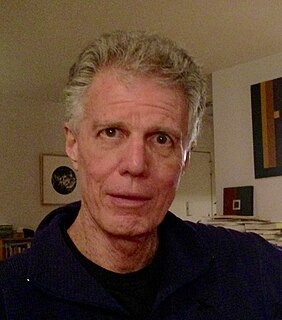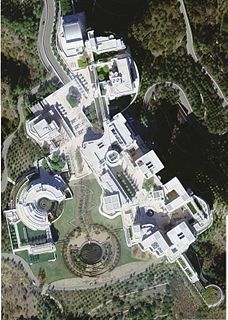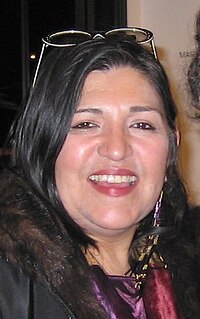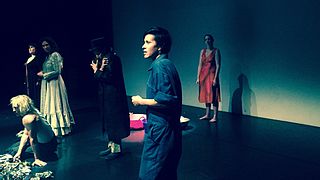
Robert C. Morgan is an American art critic, art historian, curator, poet, and artist.
Cheri Gaulke is a visual artist most known for her role in the Feminist Art Movement in southern California in the 1970s and her work on gay and lesbian families.
Jerri Allyn is an American feminist performance, installation artist and educator based in Los Angeles, California.

The Getty Research Institute (GRI), located at the Getty Center in Los Angeles, California, is "dedicated to furthering knowledge and advancing understanding of the visual arts".
Located in Hollywood, Los Angeles Contemporary Exhibitions (LACE) is a nonprofit exhibition space and archive of the visual arts for the city of Los Angeles, California, United States, currently under the leadership of Sarah Russin.

Linda Vallejo is an American artist known for painting, sculpture and ceramics. Her work often addresses her Mexican-American ethnic identity within the context of American art and popular culture. The founder of the commercial art gallery Galería Las Américas, she is also an arts educator and has been involved intraditional Native American and Mexican rituals and ceremonies for many years.
Howard Fried is an American conceptual artist who became known in the 1970s for his pioneering work in video art, performance art, and installation art.

The Painted Bride Art Center, sometimes referred to informally as The Bride, is a non-profit artist-centered performance space and gallery particularly oriented to presenting the work of local Philadelphia artists, which presents dance, jazz, world, folk and electronic music, visual arts, theatre and performance art, poetry and spoken word performances. It is located at 5212 Market Street in the West Philadelphia neighborhood of Philadelphia, Pennsylvania,
Anna Homler is a visual, performance, and vocal artist living and working in Los Angeles. She has performed music and exhibited her artworks in venues around the world. She earned a B.A. at the University of California, Berkeley, 1970, in Anthropology, and an M.A. in Education and Languages at Boston University, 1973. She graduated from Alexander Hamilton High School, Los Angeles.

ART/MEDIA was a social sculpture project in the form of series of socio-political public art events that took place in 1986 in Albuquerque and Santa Fe New Mexico. This groundbreaking artist forum featured artworks presented to the public through the mass media in a series of artist-designed billboards, television, radio and print media, and in museum exhibitions, a lecture series, and performance art series. Through this extended format, the artwork and ideas of contemporary artists were made accessible to a large public audience outside of the traditional art audience.

Nancy Buchanan is a Los Angeles-based artist best known for her work in installation, performance, and video art. She played a central role in the feminist art movement in Los Angeles in the 1970s. Her work has been exhibited widely and is collected by major museums including the Museum of Modern Art and the Centre Pompidou.
X-TRA Contemporary Art Journal (X-TRA) is an independent visual arts journal that focuses on criticism and conversation about contemporary art. X-TRA was founded in Los Angeles in 1997 by artists Stephen Berens and Ellen Birrell and is published twice a year by the non-profit Project X Foundation for Art and Criticism. The magazine is the longest running art publication in Los Angeles.

Eileen Cowin is a Los Angeles-based artist known for photography, video and mixed-media installations that draw on the language of mass media and art history and explore the relationship between narrative, fiction and non-fiction, memory and experience. Associated with the 1970s Los Angeles experimental photography scene and the Pictures Generation artists, her work combines familiar human situations and carefully chosen gestures, expressions and props to create enigmatic images whose implied, open-ended stories viewers must complete. Cowin has exhibited in more than forty solo shows in the United States and abroad, including at the Los Angeles County Museum of Art (LACMA), Museum of Contemporary Photography, Armory Center for the Arts and Contemporary Arts Center. Her work is included in more than forty institutional collections, including LACMA, the J. Paul Getty Museum, Brooklyn Museum, Art Institute of Chicago, San Francisco Museum of Modern Art (SFMOMA), and Smithsonian American Art Museum. She has been recognized with awards and commissions from the National Endowment for the Arts, LACMA, the City of Los Angeles (COLA), Public Art Fund, and the Sundance and USA film festivals. New York Times critic Andy Grundberg wrote that her multi-image work "sets up a tension between the familiar and the mysterious, creating a climate of implied danger, sexual intrigue and violence" in which clues abound to intimate various narratives. Jody Zellen observed that Cowin "manipulates the conventions of photography, film, and video to tell a different kind of story—one that explores where truth and fiction merge, yet presents no conclusions. Cowin's work provokes."
The Los Angeles Poverty Department (LAPD) is a Los Angeles-based performance group closely tied to the city's Skid Row neighborhood. Founded in 1985 by director and activist John Malpede, LAPD members are mostly homeless or formerly homeless people who collaborate with advocates, social service professionals and community members to create performances and multimedia art that highlight connections between their lived experiences and external forces that impact their lives.
CETA Artists Project (1977–1980) in New York City employed approximately 500 accomplished but underemployed artists in five programs, the largest of which was the Cultural Council Foundation (CCF) Artists Project. The project was funded under the Comprehensive Employment and Training Act (CETA) (1974–80) when more than 10,000 artists – visual, performing, and literary – were employed nationally. This was the largest number of artists supported by Federal funding since the Works Progress Administration of the 1930s.
Linda Frye Burnham is an American writer whose work and research focuses on performance art, community art, education and activism. In 1978 she was the founding editor of High Performance Magazine and later served as co-editor with Steven Durland until 1997. She has served as a staff writer for Artforum magazine, contributor to The Drama Review, among other publications. As an arts organizer Burnham co-founded in Santa Monica, California, the 18th Street Arts Center, and Highways Performance Space. In 1995 she cofounded Art in the Public Interest with Steven Durland in North Carolina, as well as cofounding the Community Arts Network in 1999 with Steven Durland, Robert Leonard and Ann Kilkelly. Burnham received a Bachelor of Arts in Humanities from the University of Southern California, and a Masters of Fine Arts in creative writing from the University of California, Irvine.

The Highways Performance Space is a performance venue in Santa Monica, California, which focuses on new works and alternative pieces. The organization is a space for LGBTQ artists to experiment with form and content. Performed work includes theatre, music, dance, spoken word, interactive media, and visual arts.

Liz Young was a Los Angeles-based artist known for diverse work investigating body- and nature-focused themes, such as loss, beauty, the inevitability of decay, and the fragility of life. She produced sculpture, installation, performance, painting, drawing and video incorporating fabricated and recontextualized found objects, organic materials, and processes from industrial metalworking to handicrafts, taxidermy and traditional art practices. Young exhibited throughout the United States and Europe, including solo shows at the Los Angeles County Museum of Art (LACMA) and Los Angeles Contemporary Exhibitions (LACE), and alternative spaces such as Hallwalls, Randolph Street Gallery (Chicago) and New Langton Arts ; she participated in group shows at Exit Art, Art in the Anchorage, and Armory Center for the Arts, among others. Her art was discussed in ARTnews, Artforum, Frieze, Los Angeles Times, The New York Times, and The Village Voice, and is included in the LACMA permanent collection. Critic Peter Frank wrote that her work "reflects both on life's relentless erosion of body and spirit, and on our indomitable struggle against these nagging cruelties." Artillery Magazine critic Ezrha Jean Black called her 2017 installation a "mordant yet elegiac show" in which "craft bears out the work’s consciousness." In 2016, Young received a Guggenheim Foundation Fellowship; she was recognized with awards from the Getty Trust and Andy Warhol Foundation, among others. Young lived and worked in Los Angeles from 1981.
CETA Employment of Artists(1974–1981) refers to the Comprehensive Employment and Training Act (CETA), which federally employed more than 10,000 artists – visual, performing, and literary – during a span of eight years. This was the largest number of artists supported by Federal funding since the Works Progress Administration (WPA) of the 1930s. It is estimated that an additional 10,000 arts support staff were funded as well. During its peak year, 1980, CETA funding for arts employment funneled up to $300 million into the cultural sector – and the economy – of the United States. In comparison, the National Endowment for the Arts budget that year was $159 million.
Astro Artz was an American publishing company founded by Susanna Dakin in the early 1980s.









